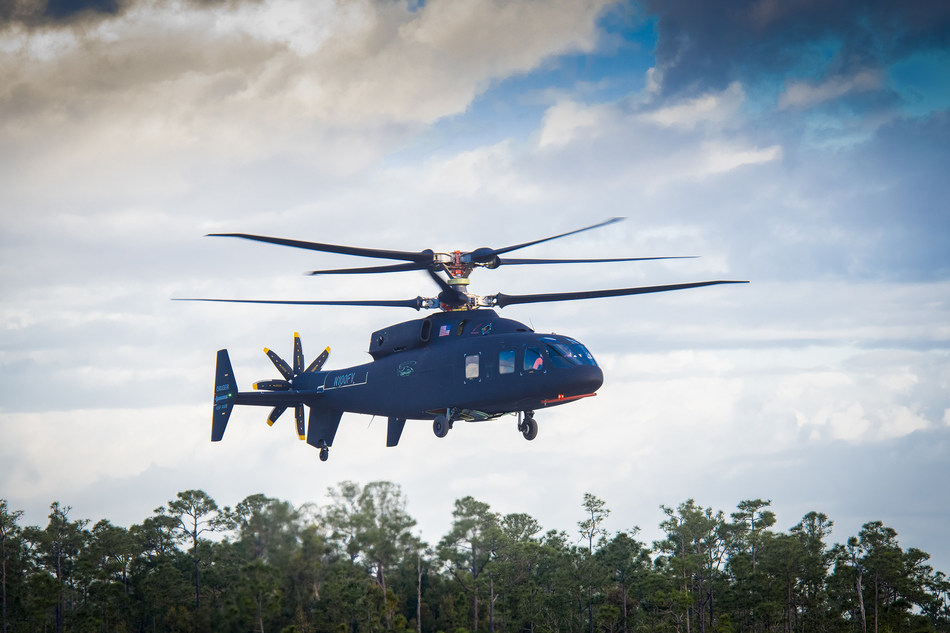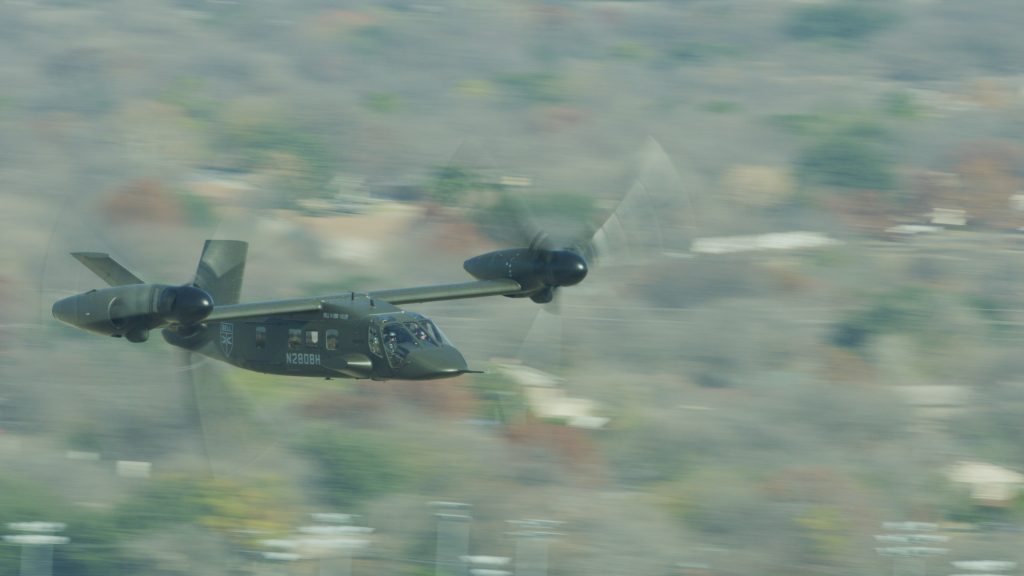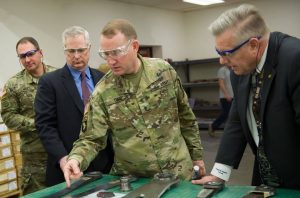
The Sikorsky-Boeing SB>1 Defiant on its first flight, March 21, 2019.
WASHINGTON: The Army is under no obligation to let the Sikorsky-Boeing team catch up to rival Bell before it holds its Future Long-Range Assault Aircraft competition, the Army Secretary and the Program Executive Officer for Aviation both made clear this week. Let that be a lesson to all the companies looking hungrily at the $33 billion the Army added to its Big Six modernization priorities.

Army Secretary Ryan McCarthy
“We’re trying to encourage business to invest and move quickly because time is the greatest commodity in life,” Sec. Ryan McCarthy told reporters after his remarks at the Brookings Institution this morning. “Time is not something we can get back. Time is not something we can negotiate.”
“We’re serious. We’ve moved billions of dollars,” he said. The world is incredibly complex. We don’t have the time or luxury to wait for people. They’ve got to keep pace with us if they want to do business with us.”
“Competition is incredibly important too, [but] ours on a prototype is one variable in a massive equation to making a decision,” McCarthy said, referring to how Bell’s V-280 Valor tiltrotor has far more flight hours and test data than the rival Sikorsky-Boeing SB>1 Defiant. “I know you guys asked that question in Texas.That’s one aspect of this competition. By no means does that declare a victor.”
I’d asked the same question in Arlington, Texas on Tuesday during Sec. McCarthy’s visit to the Bell facility there to watch the latest flight demonstration of the V-280. (Bell paid for my trip). Watching the demo and then addressing the press alongside the Army Secretary were Maj. Gen. Thomas Todd, the Army’s Program Executive Officer (PEO) for Aviation; Brig. Gen. Wally Rugen, modernization director for Future Vertical Lift; and the ranking member of the powerful House Appropriations Committee, Rep. Kay Granger, who played an instrumental role in plussing up the program so it could move faster.
“With respect to what we just saw, it’s very encouraging for us to see these demonstrators put north of 160 hours on them,” Sec. McCarthy said in Texas. “We’re going to fly it before we buy it… We’re not going to buy a billion-dollar PowerPoint slide.”

Bell V-280 Valor in flight
Excuse me, I said during Q&A, but while the V-280 has racked up over 160 flight hours in more than two years of flight tests, the rival Sikorsky-Boeing SB>1 Defiant only entered flight test last spring and still has a handful of hours in the air. (Any other potential competitor is still on the drawing board). How do you accelerate the competition when one competitor’s so far behind?
Maj. Gen. Todd took that question Tuesday. “One of the things we’ve done in the past is we’ve waited until everybody was…in the same place,” he said. But now, with the Army urgently modernizing, “we don’t want to do that. What we want to do is encourage industry to move as fast as possible.”
“There will always be a disparity between where particular vendors are,” Todd continued. “That does not mean they’re not ready to compete. That does not mean there’s not readily available test data.”

Then-Brig. Gen. Thomas Todd inspects Boeing’s AH-64 Apache production facility.
The Army and the Sikorsky-Boeing team have repeatedly insisted there is enough test data on the Defiant to move ahead. But Todd acknowledged today that having more test data – as the V-280 does – is indeed an advantage, because it helps prove the aircraft works as designed. The more flight tests, the less uncertainty.
“The advantage that any of them have if they choose to have aggressive schedules …is ultimately they burn down risk,” he said.
“Yes, many competitors will be in different places when we actually run the [competitive] downselect,” Todd concluded. “We want them in a place where we have at least good test data.”
Now, Bell’s lead isn’t as insurmountable as it might appear, because it will have to make at least some changes to the V-280 design. Both the V-280 and the Sikorsky-Boeing SB>1 were built under the Joint Multi-Role Tech Demonstrator effort. That means they’re not officially prototypes, just demonstrations of the state of the art. Now the Army has used the JMR data to write its official requirements for FLRAA, and both companies will have to refine their designs at least somewhat to meet them.

A UH-60 Black Hawk takes off after unloading soldiers during an air assault exercise in Germany. Bell’s V-280 and the Sikorsky-Boeing SB>1 are vying to replace the Black Hawk.
The JMR demo, in fact, is officially over, as of last fall. But Congress gave the Army additional funding to continue test flights. The V-280 is basically using those flights to get extra credit, doing tests the Army didn’t mandate such as fast-roping troops out of the aircraft during a hover and having the aircraft’s computer fly it without human intervention. We don’t know specifically what Defiant is doing, but it had plenty to catch up on.
In March, the Army is expected to award both companies contracts for “competitive demonstration and risk reduction.” (In theory, the Army will award one or two CDRR contracts, to whatever competitor is most qualified, but only Bell and Sikorsky-Boeing are flying, so it’s overwhelmingly likely they’ll each get an award and no one else will). Then it’ll choose the winning design in 2022, with aircraft entering operational service by 2030.
Moving fast carries with it its own risks, especially if the Army is willing to dispense with competition and commit to one company that’s ahead of its rival. Last year, the service effectively did just that on its Bradley combat vehicle replacement, the Optionally Manned Fighting Vehicle, when it disqualified the Rheinmetall-Raytheon team for not delivering their prototype to the test facility on time, leaving only General Dynamics in contention. That decision was controversial, to say the least. Repeating it on the Black Hawk replacement would be explosive.
In a ‘world first,’ DARPA project demonstrates AI dogfighting in real jet
“The potential for machine learning in aviation, whether military or civil, is enormous,” said Air Force Col. James Valpiani. “And these fundamental questions of how do we do it, how do we do it safely, how do we train them, are the questions that we are trying to get after.”


























